Improvement and In-Situ Application of an Evaluation Method of Ballasted-Track Condition Using Digital 2-D Image Analysis
Abstract
1. Introduction
2. Image Analysis Method
2.1. Summary of Previous Research
- (1)
- All gravels used for high-speed railways are provided by the same supplier.
- (2)
- Mud pumping in the roadbed rarely occurs owing to reinforced roadbeds in the lower part of high-speed railways.
- (1)
- Roundness was the ratio of the area of a circle, with the major axis of the gravel as the diameter, to the aggregate area, and is calculated using the equation proposed by Ferreira et al. [21].where A is the area of a gravel aggregate, and Lmajor is the major axis length of the gravel. A small roundness indicates that particle is angular, while a large roundness indicates that particle is circular.
- (2)
- Sphericity was the ratio of the circumference of a circle, with the same area as the gravel aggregate, to the circumference of the gravel particle, and is calculated using the equation proposed by Altuhafi et al. [22].where Le is circumference of a circle that has the same area as the gravel aggregate, and b is the circumference of the gravel particle. A small sphericity indicates that surface of particle is coarse, while a large sphericity indicates that surface of particle is smooth.
- (3)
- Aspect ratio was calculated as the ratio of the major axis to the minor axis of the gravel; thus, its value is always greater than 1.0, unlike other shape indices.
- (4)
- Angularity was calculated as proposed by Wang et al. [23], in which the shape of gravel aggregates is represented using Fourier coefficients and then calculated as the sum of the squares of the coefficients of high-frequency bands.
2.2. Improvement of Image Analysis Method
2.2.1. Change in Background Color
2.2.2. Change in the Aggregate Segmentation Procedure Algorithm
2.2.3. Result of the Improved Aggregate Segmentation
2.2.4. Development of Image Analysis Software
3. Field Test
3.1. Field Test Overview
3.2. Image Analysis Results
3.2.1. Applicability of Shape Indices
3.2.2. Image Analysis Results According to the Sampling Depth
3.2.3. Sieve Analysis Results According to the Sampling Depth
4. Track Condition Evaluation Based on the Image Analysis Method
5. Conclusions
- When the background color for taking images of gravel aggregates was changed and the image analysis algorithm was improved, the aggregate segmentation rate was significantly increased. The segmentation rate of a previous method ranged from 51 to 100%, as it was considerably affected by the image shooting environment, whereas that of the improved method was 100% regardless of the image shooting environment.
- When the image analysis was performed on the samples collected from various location of a high-speed railway, the results revealed that roundness has the highest correlation with TQI, whereas sphericity has the highest correlation with the number of maintenance works. However, aspect ratio and angularity exhibited a low correlation with other shape indices owing to over simplification of a gravel shape and the limitation of the analysis method.
- It was discovered that the correlation can be detected when the gravel samples are collected from the surface, as well as from the middle layer of a high-speed railway for the image analysis.
- If the abrasion of the ballast aggregates approaches to about 10%, the ballast layer would be replaced in order to enhance maintenance efficiency.
Author Contributions
Funding
Conflicts of Interest
References
- Kumara, J.J.; Hayano, K. Deformation characteristics of fresh and fouled ballasts subjected to tamping maintenance. Soils Found. 2016, 56, 652–663. [Google Scholar] [CrossRef]
- Boler, H.; Qian, Y.; Tutumluen, E. Influence of size and shape properties of railroad ballast on aggregate packing statistical analysis. Transp. Res. Rec. 2014, 2448, 94–104. [Google Scholar] [CrossRef]
- Indraratna, B.; Salim, W.; Rujikiatkamjorn, C. Advanced Rail Geotechnology-Ballasted Track; CRC Press: Boca Raton, FL, USA, 2011. [Google Scholar]
- Salim, W. Deformation and Degradation Aspects of Ballast and Constitutive Modelling under Cyclic Loading. Ph.D. Thesis, University of Wollongong, Wollongong, NSW, Australia, 2004. [Google Scholar]
- Korea Railroad Corporation. Korea Railroad Corporation Standard: Ballast (KRCS A015-07); Korea Railroad Corporation: Daejeon, Korea, 2017. [Google Scholar]
- Korea National Railway. Railway Track Maintenance Guidelines; Korea National Railway: Daejeon, Korea, 2016. [Google Scholar]
- Masad, E.; Fletcher., T. Aggregate Imaging System (AIMS): Basics and Application; Texas Transportation Institute: Dallas, TX, USA, 2005; Volume Report 5-1.
- Mahmoud, E.; Gates, L.; Masad, E.; Erdoğan, S.; Garboczi, E. Comprehensive evaluation of AIMS texture, angularity, and dimension measurements. J. Mater. Civ. Eng. 2010, 22, 369–379. [Google Scholar] [CrossRef]
- Tutumluer, E.; Rao, C.; Stefanski, J.A. Video Image Analysis of Aggregates; Federal Highway Administration: IL, USA, 2000.
- Tutumluer, E.; Pan, T.; Carpenter, S.H. Investigation of Aggregate Shape Effects on Hot Mix Performance Using an Image Analysis Approach; Federal Highway Administration: Springfield, IL, USA, 2005.
- Kim, J.; Park, B.-S.; Woo, S.I.; Choi, Y.-T. Evaluation of ballasted-track condition based on aggregate-shape characterization. Constr. Build. Mater. 2020, 232, 117082. [Google Scholar] [CrossRef]
- Kim, H.; Haas, C.T.; Rauch, A.F.; Browne, C. Wavelet-Based Three-Dimensional Descriptors of Aggregate Particles. Transp. Res. Rec. 2002, 1787, 109–116. [Google Scholar] [CrossRef]
- Tolppanen, P. 3-D Characterization and Degradation Analysis of Rock Aggregates. Ph.D. Thesis, Royal Institute of Technology, Stockholm, Sweden, 2001. [Google Scholar]
- Garboczi, E.J. Three-dimensional mathematical analysis of particle shape using X-ray tomography and spherical harmonics: Application to aggregates used in concrete. Cem. Concr. Res. 2002, 32, 1621–1638. [Google Scholar] [CrossRef]
- Ouhbi, N.; Voivret, C.; Perrin, G.; Roux, J.N. Railway Ballast: Grain Shape Characterization to Study its Influence on the Mechanical Behaviour. Procedia Eng. 2016, 143, 1120–1127. [Google Scholar] [CrossRef]
- Guo, Y.; Markine, V.; Zhang, X.; Qiang, W.; Jing, G. Image analysis for morphology, rheology and degradation study of railway ballast: A review. Transp. Geotech. 2019, 18, 173–211. [Google Scholar] [CrossRef]
- Korean Agency for Technology and Standards. Method of Test for Resistance to Abrasion of Coarse Aggregate by Use of the Los Angeles Machine(KS F 2508-2007); Korean Agency for Technology and Standards: Chungcheongbuk-do, Korea, 2007. [Google Scholar]
- ASTM International. Standard Test Method for Resistance to Degradation of Large -Size Coarse Aggregate by Abrasion and Impact in the Los Angeles Machine(ASTM C131/C131M-14); ASTM International: West Conshohocken, PA, USA, 2014. [Google Scholar]
- Barrett, P. The shape of rock particles, a critical review. Sedimentology 1980, 27, 291–303. [Google Scholar] [CrossRef]
- Rodriguez, J.M.; Edeskär, T.; Knutsson, S. Particle shape quantities and measurement techniques—A review. Electron. J. Geotech. Eng. 2013, 18, 169–198. [Google Scholar]
- Ferreira, T.; Rasband, W. ImageJ User Guide IMAGEJ/FIJI 1.46; IJ 1.46r; 2012. Available online: http://imagej.nih.gov/ij/docs/guide/user-guide.pdf (accessed on 8 November 2020).
- Altuhafi, F.N.; Coop, M.R.; Georgiannou, V.N. Effect of particle shape on the mechanical behavior of natural sands. J. Geotech. Geoenviron. Eng. 2016, 142. [Google Scholar] [CrossRef]
- Wang, L.; Park, J.; Mohammad, L. Quantification of Morphology Characteristics of Aggregate from Profile Images. In Proceedings of the 82nd Transportation Research Board Annual Meeting, Washington, DC, USA, 12–16 January 2003; pp. 1–23. [Google Scholar]
- Mitchell, J.K.; Soga, K. Fundamentals of Soil Behavior, 3rd ed.; John Wiley & Sons: Hoboken, NJ, USA, 2005. [Google Scholar]
- Beucher, S. The Watershed Transformation Applied to Image Segmentation. In Proceedings of the 10th Pfefferkorn Conference on Signal and Image Processing in Microscopy and Microanalysis, Cambridge, UK, 27–30 September 1991; pp. 299–314. [Google Scholar]
- Santamarina, J.C.; Cho, G.C. Soil behaviour: The role of particle shape. In Proceedings of the Advances in Geotechnical Engineering: The Skempton Conference—Proceedings of a Three Day Conference on Advances in Geotechnical Engineering, organised by the Institution of Civil Engineers, London, UK, 29–31 March 2004; Thomas Telford: London, UK, 2004; Volume 1, pp. 604–617. [Google Scholar]
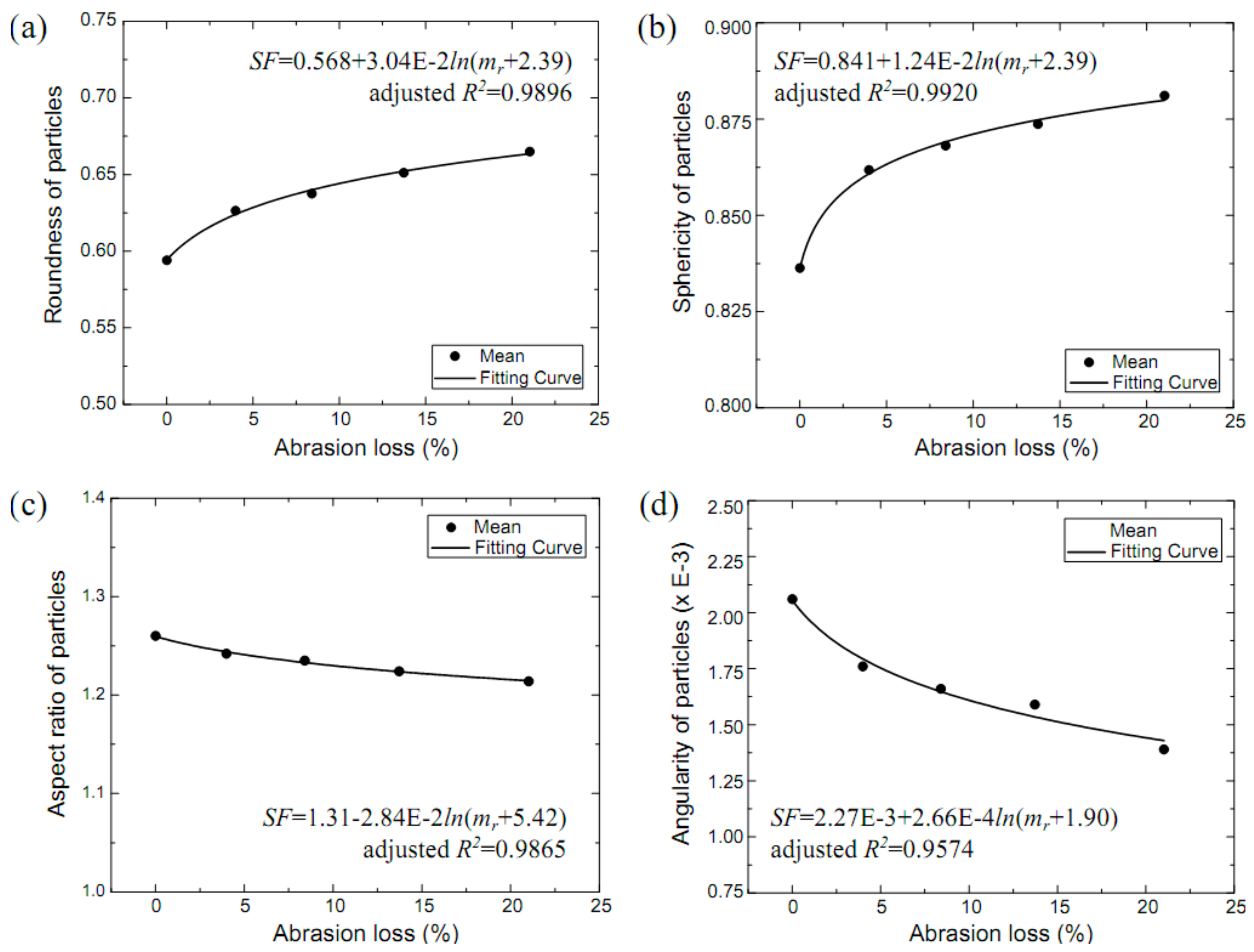
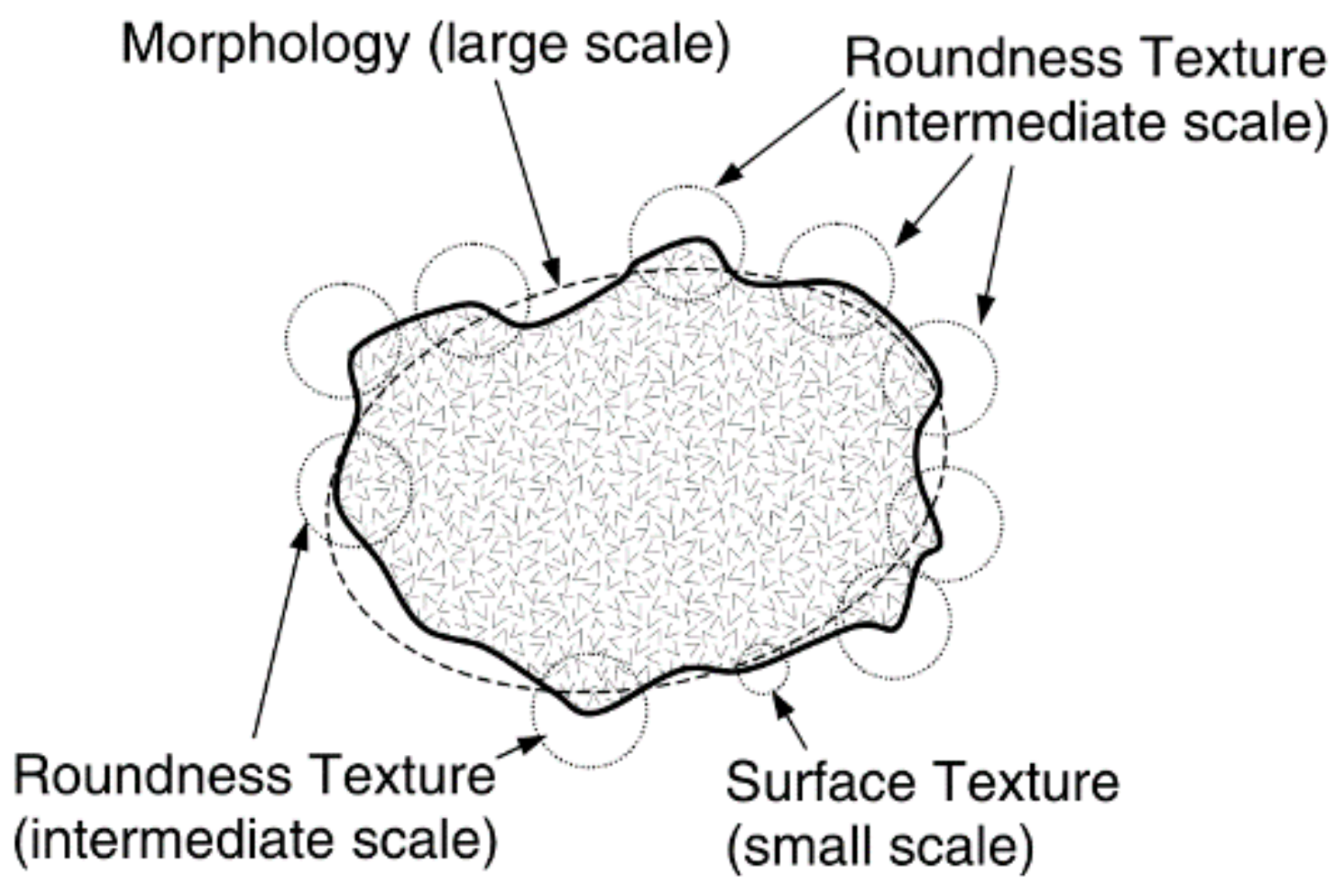


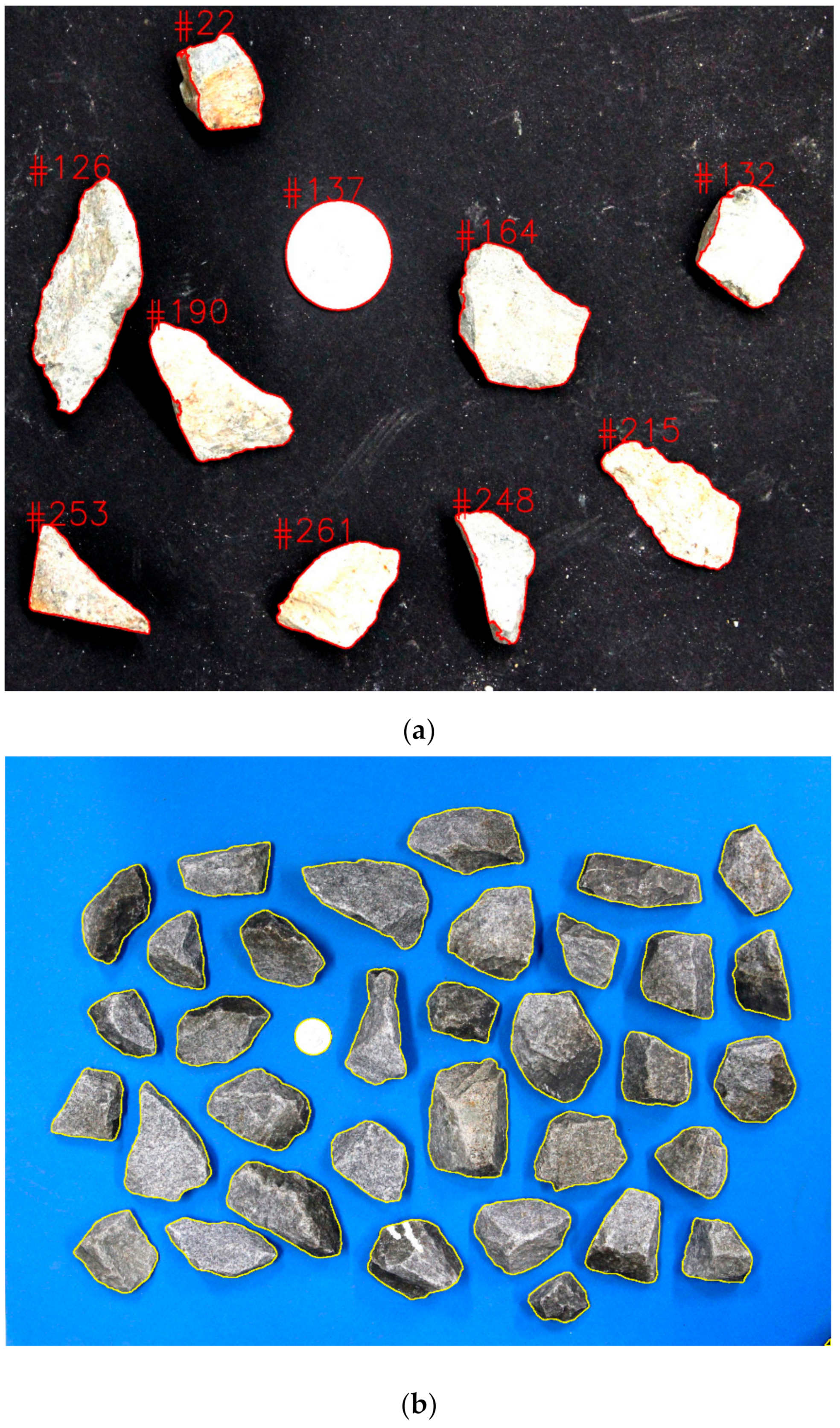
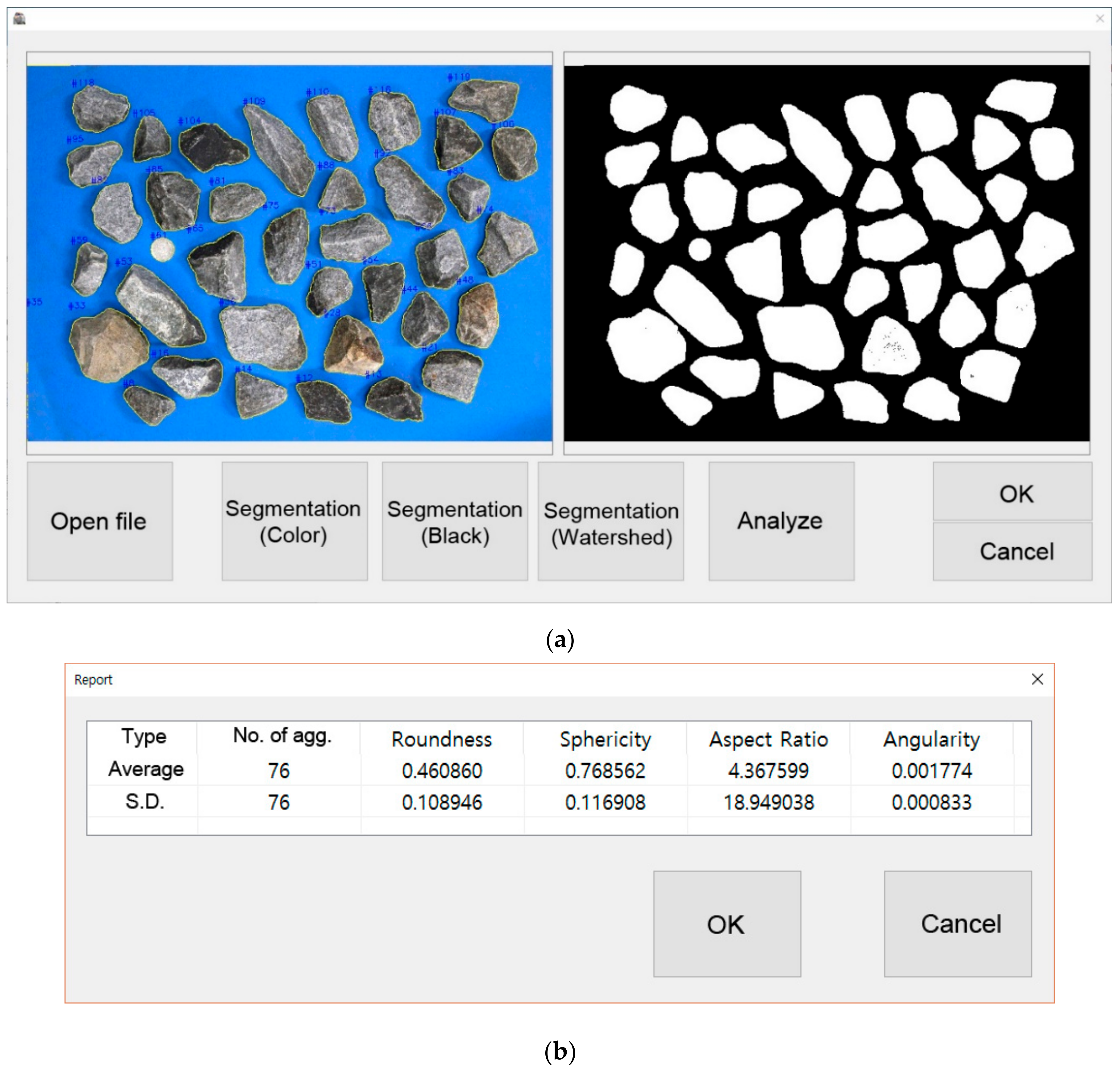
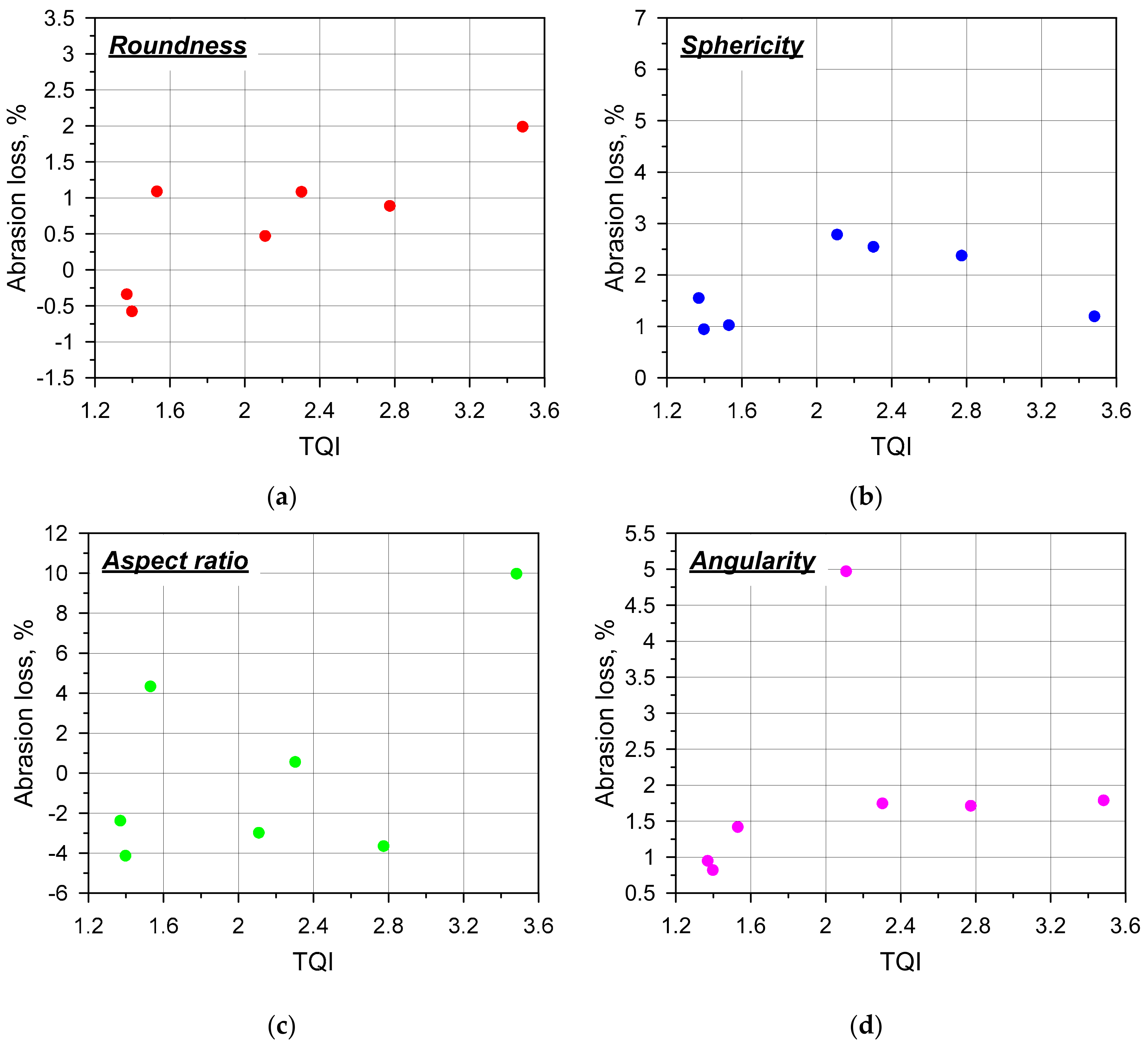
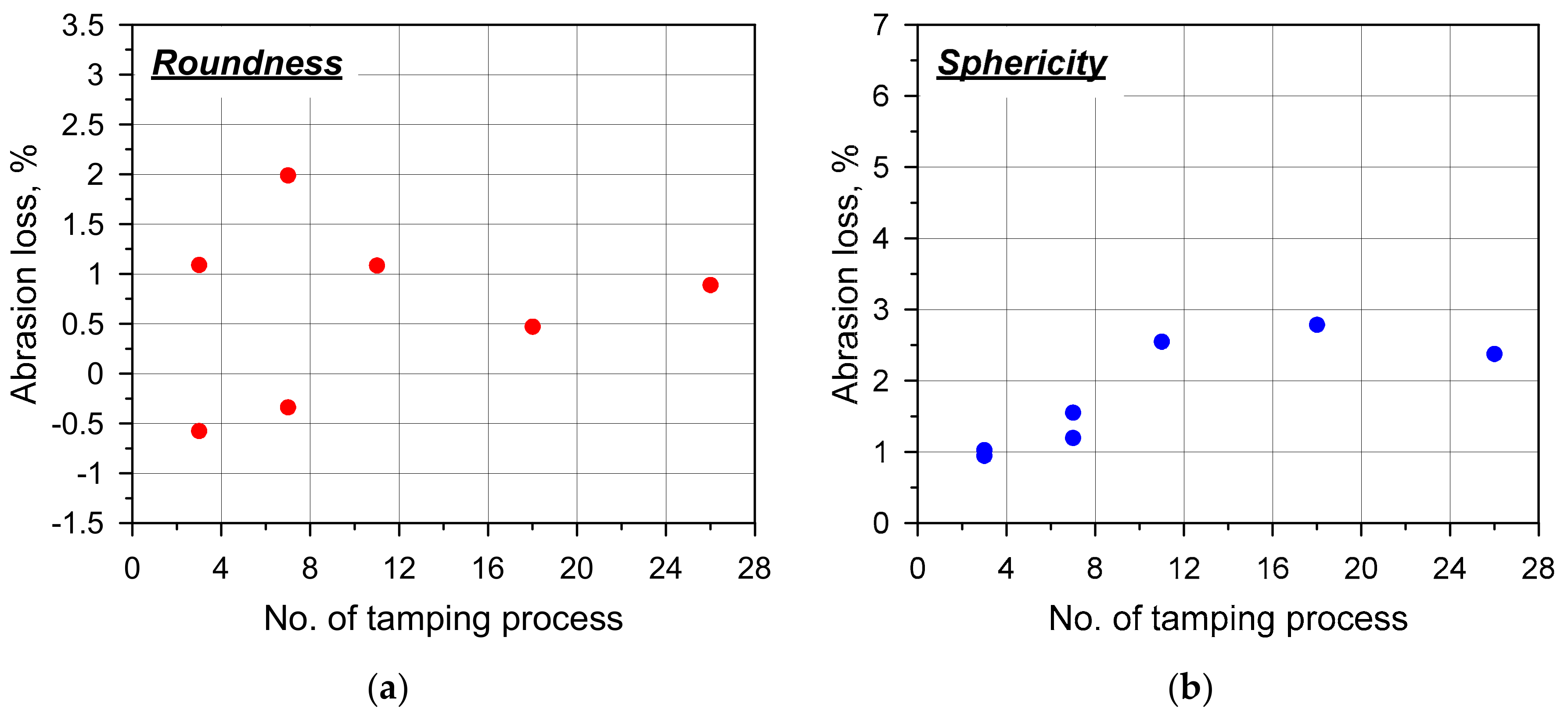
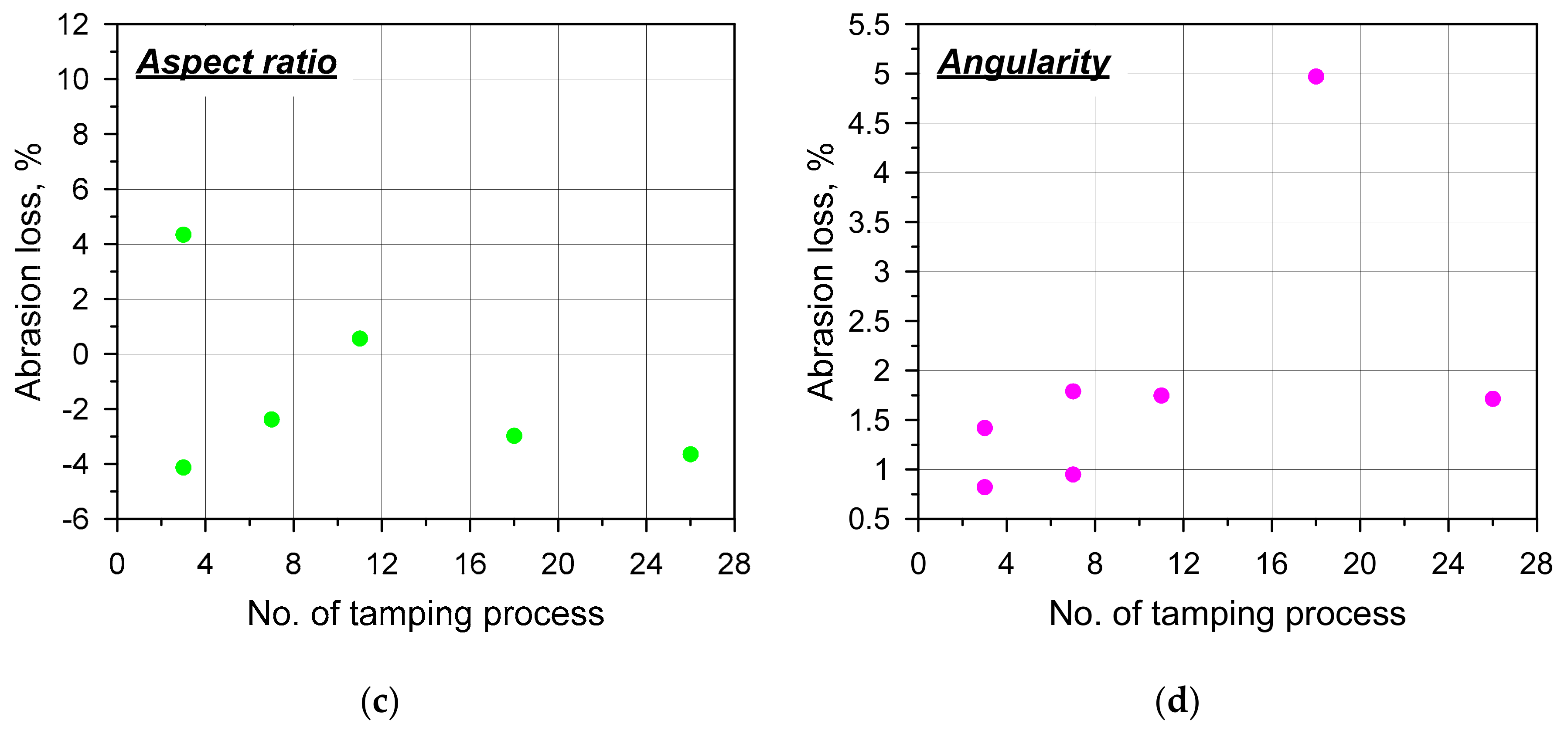



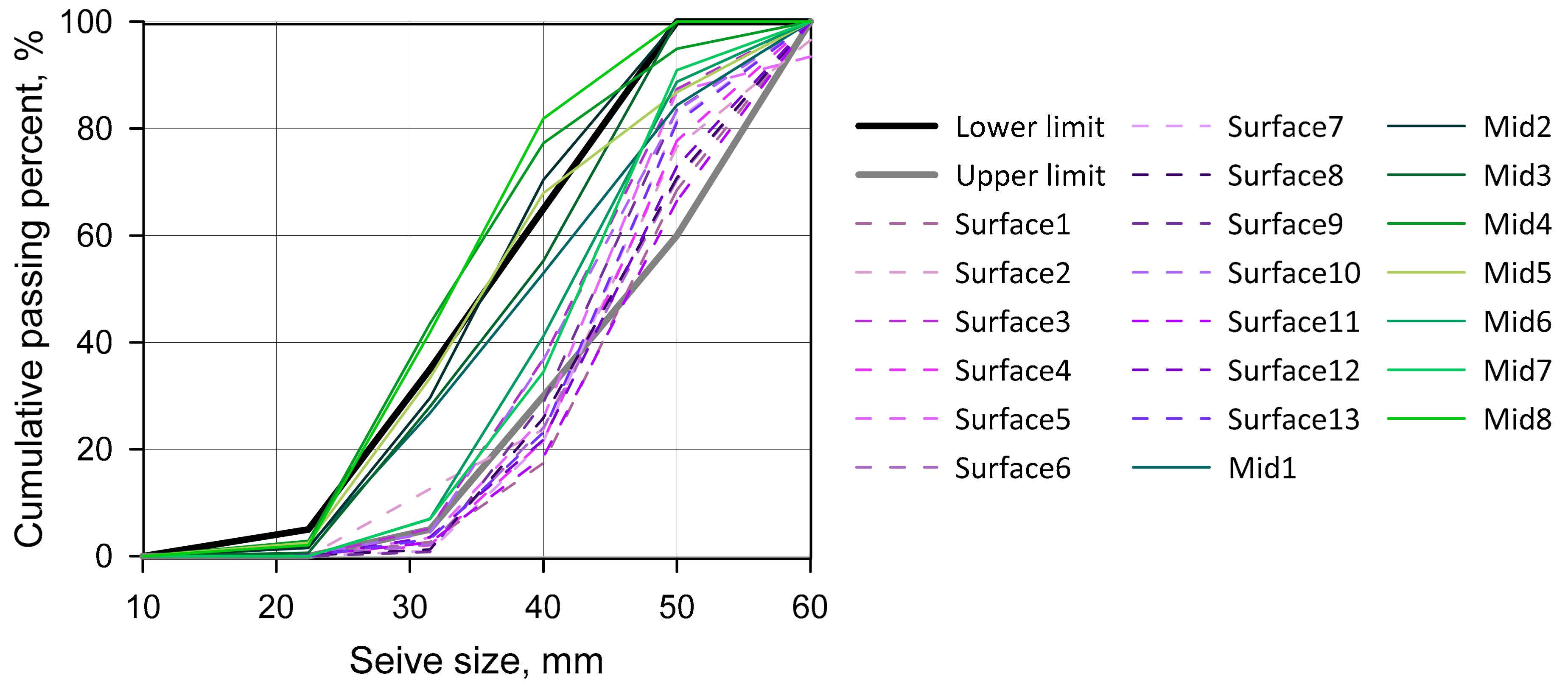
| Scale | Shape Characterization | Shape Index in This Research |
|---|---|---|
| Large | Morphology | Roundness, Aspect ratio |
| Intermediate | Roundness texture | Sphericity |
| Small | Surface texture | Angularity |
| Sampling Point | No. of Total Aggregates | No. of Segmented Aggregates | |
|---|---|---|---|
| Previous Method | Improved Method | ||
| Location 1 | 118 | 90 (76%) | 118 (100%) |
| Location 2 | 17 | 13 (76%) | 17 (100%) |
| Location 3 | 70 | 36 (51%) | 70 (100%) |
| Location 4 | 35 | 32 (91%) | 35 (100%) |
| Location 5 | 40 | 34 (85%) | 40 (100%) |
| Location 6 | 49 | 41 (84%) | 49 (100%) |
| Location 7 | 42 | 37 (88%) | 42 (100%) |
| Location 8 | 57 | 55 (96%) | 57 (100%) |
| Location 9 | 46 | 46 (100%) | 46 (100%) |
| Location 10 | 87 | 87 (100%) | 87 (100%) |
| Year of Measurement | Section Name | Location | Structure Category | Sampling Depth | No. of Aggregates |
|---|---|---|---|---|---|
| 2017 | Galhang overpass | T2 241k295 | Bridge | - | 46 |
| Wunyong overpass 1 | T2 078k465 | Earthwork | - | 54 | |
| Wunju tunnel | T1 112k000 | Tunnel | - | 337 | |
| Seobong tunnel 2 | T1 053k562 | Tunnel | - | 445 | |
| 2018 | Shinhue overpass | T2 085k400 | Bridge | Surface | 118 |
| Godeung tunnel | T2 107k270 | Earthwork | Surface, Mid, Bottom | 52, 17, 18 | |
| T2 107k440 | Tunnel | Surface | 70 | ||
| Pungsae Bridge | T1 099k700 | Earthwork | Surface | 35 | |
| T2 099k700 | Earthwork | Surface, Mid | 40, 43 | ||
| T2 100k300 | Bridge | Surface, Mid | 49, 61 | ||
| T2 100k500 | Bridge | Surface | 42 | ||
| Yongwa tunnel | T2 089k110 | Tunnel | Surface | 57 | |
| T2 089k310 | Earthwork | Surface, Mid | 46, 76 | ||
| Paengseong overpass 1 | T2 075k570 | Earthwork | Mid | 88 | |
| T2 075k670 | Bridge | Surface, Mid | 54, 57 | ||
| Geumgang Bridge | T1 183k220 | Earthwork | Mid | 59 | |
| T1 183k430 | Earthwork | Surface, Mid | 78, 87 |
| No. of Cycle | Residual Weight (kg) | % of Passing (22.4 mm) | |||||
|---|---|---|---|---|---|---|---|
| 50 mm | 40 mm | 31.5 mm | 22.4 mm | Etc. | Total | ||
| 0 | 2.02 | 3.38 | 2.80 | 1.81 | 0.00 | 10.00 | 0.0 |
| 200 | 1.08 | 3.11 | 2.54 | 2.23 | 0.95 | 9.92 | 9.6 |
| 300 | 1.11 | 3.05 | 2.41 | 2.05 | 1.29 | 9.91 | 13.0 |
| 500 | 0.77 | 2.43 | 2.44 | 2.51 | 1.73 | 9.87 | 17.6 |
| 1000 | 0.38 | 2.30 | 2.35 | 2.41 | 2.28 | 9.72 | 23.5 |
| 2000 | 0.27 | 2.30 | 2.10 | 2.31 | 2.62 | 9.60 | 27.3 |
| No. of Cycle | Abrasion Loss (%) | Shape Index | |||
|---|---|---|---|---|---|
| Roundness | Sphericity | Aspect Ratio | Angularity | ||
| 0 | 0.00 | 0.595 | 0.836 | 1.260 | 0.00209 |
| 200 | 3.05 | 0.618 | 0.854 | 1.253 | 0.00176 |
| 300 | 3.99 | 0.626 | 0.862 | 1.242 | 0.00176 |
| 500 | 8.41 | 0.638 | 0.868 | 1.235 | 0.00166 |
| 703 | 10.57 | 0.646 | 0.871 | 1.231 | 0.00160 |
| 1000 | 13.73 | 0.651 | 0.874 | 1.224 | 0.00159 |
| 2000 | 21.03 | 0.665 | 0.881 | 1.214 | 0.00139 |
Publisher’s Note: MDPI stays neutral with regard to jurisdictional claims in published maps and institutional affiliations. |
© 2020 by the authors. Licensee MDPI, Basel, Switzerland. This article is an open access article distributed under the terms and conditions of the Creative Commons Attribution (CC BY) license (http://creativecommons.org/licenses/by/4.0/).
Share and Cite
Park, B.; Choi, Y.-T.; Kim, H. Improvement and In-Situ Application of an Evaluation Method of Ballasted-Track Condition Using Digital 2-D Image Analysis. Appl. Sci. 2020, 10, 7946. https://doi.org/10.3390/app10217946
Park B, Choi Y-T, Kim H. Improvement and In-Situ Application of an Evaluation Method of Ballasted-Track Condition Using Digital 2-D Image Analysis. Applied Sciences. 2020; 10(21):7946. https://doi.org/10.3390/app10217946
Chicago/Turabian StylePark, Bongsik, Yeong-Tae Choi, and Hyunmin Kim. 2020. "Improvement and In-Situ Application of an Evaluation Method of Ballasted-Track Condition Using Digital 2-D Image Analysis" Applied Sciences 10, no. 21: 7946. https://doi.org/10.3390/app10217946
APA StylePark, B., Choi, Y.-T., & Kim, H. (2020). Improvement and In-Situ Application of an Evaluation Method of Ballasted-Track Condition Using Digital 2-D Image Analysis. Applied Sciences, 10(21), 7946. https://doi.org/10.3390/app10217946




